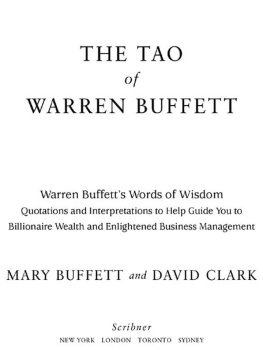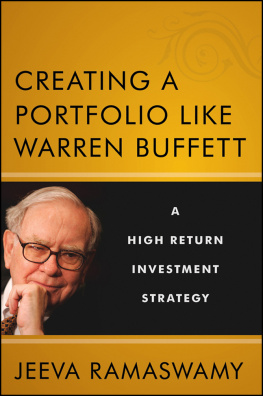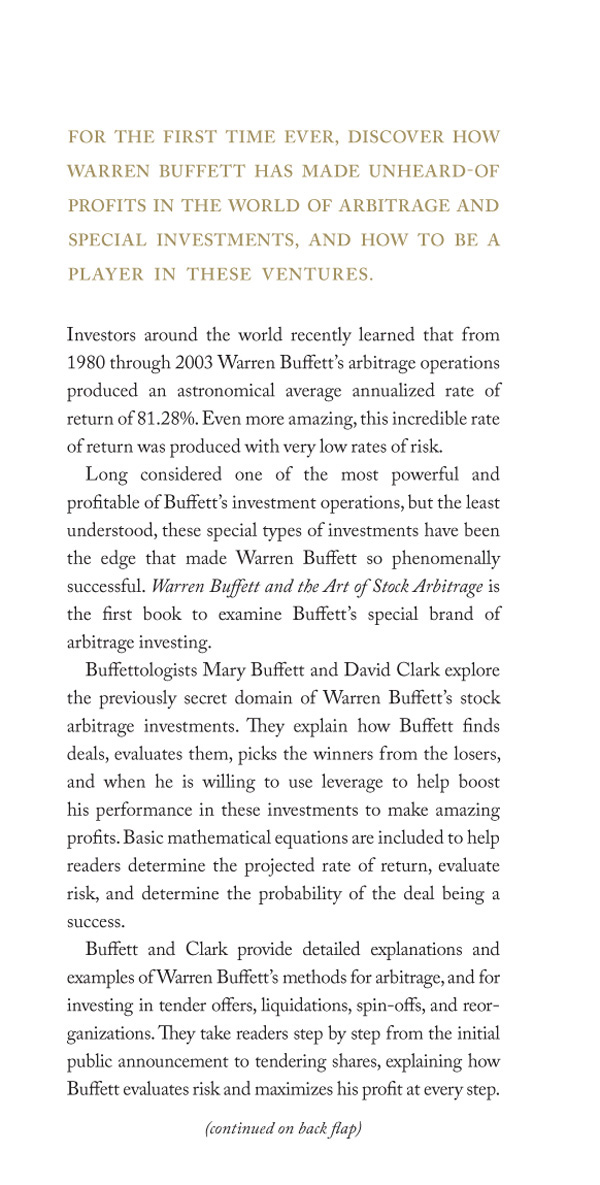
ALSO BY MARY BUFFETT AND DAVID CLARK
Buffettology
Buffettology Workbook
The New Buffettology
The Tao of Warren Buffett
Warren Buffett and the Interpretation of Financial Statements
Warren Buffetts Management Secrets

SCRIBNERx
A Division of Simon & Schuster, Inc.
1230 Avenue of the Americas
New York, NY 10020
www.SimonandSchuster.com
Copyright 2010 by Mary Buffett and David Clark
All rights reserved, including the right to reproduce this book or portions thereof in any form whatsoever. For information address Scribner Subsidiary Rights Department, 1230 Avenue of the Americas, New York, NY 10020.
First Scribner hardcover edition November 2010
SCRIBNER and design are registered trademarks of The Gale Group, Inc., used under license by Simon & Schuster, Inc., the publisher of this work.
For information about special discounts for bulk purchases, please contact Simon & Schuster Special Sales at 1-866-506-1949 or business@simonandschuster.com.
The Simon & Schuster Speakers Bureau can bring authors to your live event. For more information or to book an event contact the Simon & Schuster Speakers Bureau at 1-866-248-3049 or visit our website at www.simonspeakers.com.
Designed by Kyoko Watanabe
Text set in Sabon
Manufactured in the United States of America
1 3 5 7 9 10 8 6 4 2
ISBN 978-1-4391-9882-7
ISBN 978-1-4516-0645-4 (ebook)
This publication contains the opinions and ideas of its authors. It is not a recommendation to purchase or sell any of the securities of any of the companies mentioned or discussed herein. It is sold with the understanding that the authors and publishers are not engaged in rendering legal, accounting, investment, or other professional advice or services. Laws vary from state to state and federal laws may apply to a particular transaction, and if the reader requires expert financial or other assistance or legal advice, a competent professional should be consulted. Neither the authors nor the publisher can guarantee the accuracy of the information contained herein. The authors and publishers specifically disclaim any responsibility for any liability, loss, or risk, personal or otherwise, which is incurred as a consequence, directly or indirectly, of the use and application of any of the contents of this book.
This book is dedicated to the late Benjamin Graham
The man who taught Warren Buffett
the art of stock arbitrage
Give a man a fish and you will feed him for a day. Teach a man to arbitrage and you will feed him forever.
Warren Buffett
INTRODUCTION
One of the great secrets of Warren Buffetts investment success has been his arbitrage and special situations investments. They have been kept out of the public eye, in part, because there has been so little written about them. Also, because brokerage costs that lay investors were forced to pay were often ten to twenty times that of professional investors, arbitrage and special situations have up until now been the sole domain of professional investment trusts and partnerships, who could command much lower brokerage rates.
Previously, brokerages have had two sets of rates: they have had retail rates for lay investors and institutional rates for professional investors. A trade that would cost a retail customer $3,000 might cost an institutional client as little as $150. In the world of arbitrage and special situations, where the per-share profit is often under a dollar, the high retail brokerage rates formed an almost impassable barrier of entry for lay investors, simply because their brokerage costs often exceeded any potential profit in the trade.
In the late 1990s, with the advance of the Internet, brokerages started offering online trading at deep discounts from their full-service retail rates. The absence of a human broker taking the order resulted in greater cost efficiencies, which resulted in the ability to offer individual retail clients lower institutional brokerage rates. With the lower rates the world of stock arbitrage and other special situations suddenly opened up to the masses. Sitting alone with a computer and an online brokerage account with deeply discounted trading rates, an individual investor could compete in the field of arbitrage with even the most powerful of Wall Street firms.
Warren Buffett is probably the greatest player in the arbitrage and special situations game today. Not because he takes the biggest risks. Just the oppositebecause he learned how to identify the bet with the least risk, which has enabled him to take very large positions, and produce results that can only be described as spectacular.
In professors Gerald Martin and John Puthenpurackals studyonly beat his regular portfolios performance, it also stomped the average annualized performance of every investment operation in America by a mile. No onebe it individual or firmeven came close. (And people wonder how he made so many people millionaires! With such incredible returns how could he not?)
Martin and Puthenpurackals study also brought to light the powerful influence that Warrens arbitrage operations had on Berkshires stock portfolios entire performance. If we cut out Warrens 59 arbitrage investments for that period, we would find that the average annualized return for Berkshires stock portfolio drops from 39.38% to 26.96%. It was Warrens arbitrage investments that took a great investor and turned him into a worldwide phenomenon.
In 1987, Forbes magazine noted that Warrens arbitrage activities earned an amazing 90% that year, while the S&P 500 delivered a miserable 5%. Arbitrage is Warrens secret for producing great results when the rest of the stock market is having a down year.
With Warrens incredible arbitrage performance in mind, and the knowledge that the average investor now has access to institutional brokerage rates, we thought it was high time that we took a serious look at the arbitrage and special situation investment strategies and techniques that produce Warrens mind-numbing results.
Warren Buffett and the Art of Stock Arbitrage is the first-ever book to explore in detail Warrens world of stock arbitrage and other special situations such as liquidations, spin-offs, and reorganizations. Together we explore how he finds the deals, evaluates them, and makes sure that they are winners. We go into the mathematical equations and intellectual formulas that he uses to determine his projected rate of return, to evaluate risk, and to determine the probability of the deal being a success. In Warrens world, as you will discover, certainty of the deal being completed is everything. We will explain how the high probability of the event happening creates the rare situation in which Warren is willing to use leverage to help boost his performance in these investments to unheard-of numbers.
So without further ado, lets begin our very profitable journey into the world of Warren Buffett and the Art of Stock Arbitrage.
MARY BUFFETT AND DAVID CLARK
).
WARREN BUFFETT AND THE ART OF STOCK ARBITRAGE
CHAPTER 1












